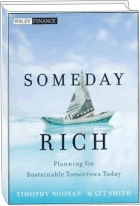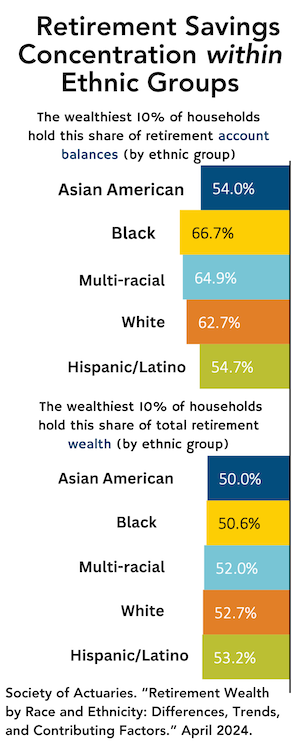
Someday Rich, the new book by Russell Investments veterans Tim Noonan and Matt Smith, is a must-read for retirement planners, not just because it offers a clear model for evaluating each client’s retirement needs, but also because it shows how this approach can build trust and closeness with affluent clients.
 The book’s authors—Noonan is managing director of capital markets at Russell Investments and Smith is a consultant and former Russell managing director—detail a methodology, linked to ideas published several years ago by their former colleague, Richard Fullmer, that applies the institutional framework for measuring pension liabilities to individuals.
The book’s authors—Noonan is managing director of capital markets at Russell Investments and Smith is a consultant and former Russell managing director—detail a methodology, linked to ideas published several years ago by their former colleague, Richard Fullmer, that applies the institutional framework for measuring pension liabilities to individuals.
Their “personal asset liability model” yields a ratio that addresses the question that clients care about most: Can I retire comfortably? Clients who have a ratio of 100%—that is, if they have enough invested savings to purchase a life annuity that could cover their important needs in retirement—are considered to be fully funded.
The Russell system gives life annuities a kind of backhanded compliment by using their purchase price as a threshold for staying fully invested. As long as a client has at least enough savings to pay for an annuity that can cover his or her future needs, the authors explain, the client can afford to postpone such a purchase.
If the client never needs an annuity, that’s ideal, they say. If the client merely delays the purchase of an annuity, that would be good too. For one, the cost of a lifetime income stream falls as the client ages. Second, most clients are happy to keep their assets outside an annuity for as long as possible. Finally, a delay lets fee-based advisers keep assets under management that much longer.
Clients with funded ratios between 85% and 130% (and who have savings of roughly $500,000 to $1.5 million) represent the “sweet spot” for the Someday Rich method. Clients with funded ratios of less than 85% usually have no choice but to buy an annuity if they want to mitigate longevity risk. Clients with funded ratios above 130% tend to be more preoccupied with estate planning than longevity risk. (Editor’s note: These categories correspond more or less to Jim Otar’s “Yellow Zone,” “Red Zone,” and “Green Zone” clients, respectively.)
By making those in-between clients more aware of their funded ratio, the authors say, advisors can do them a big favor. The funded ratio indicates whether clients should think about working longer, investing differently, saving more, or spending less as they approach or transition into retirement. At the very least, showing clients their individualized funded status can spark a much more meaningful conversation than merely talking in generalities about asset allocation or fund performance.
How to maintain funded status
A client’s potential for earned income—i.e., their “human capital”—will likely have the greatest impact on his or her funding ratio, the book says. But it’s just one of many factors. How much the clients save, spend and invest also affects the funded ratio, obviously, as do wild card factors like interest rates and share prices.
As retirement approaches and one’s human capital declines or ends completely, the investment portfolio becomes more vulnerable to those wild card factors. During that transition period—when investment losses can, if not handled properly, do lasting damage to retirement security—advisors need to manage each client’s assets closely and, if possible, improve their funded ratio.
Someday Rich shows advisors how to engage with clients to determine the most effective withdrawal rates during retirement. Advisors can propose a variety of withdrawal rates and asset allocations, and demonstrate the probability that each combination will generate a long-range surplus or shortfall. Armed with that information, clients are better able to decide how much to spend or, alternately, how much to leave to heirs.
As for the wisdom of increasing a client’s bond allocation as her or she nears retirement, the authors suggest using each client’s funded status as a guide. They recommend an “adaptive asset allocation method in which the advisor dynamically adjusts their [clients’] portfolio risk with respect to their funded status.” This entails buying stocks when stocks go up and selling when stocks go down—a downside-protection strategy that may strike some advisors as counter-intuitive.
To maintain or improve the funded ratio, the authors also suggest “dynamic hedging strategies,” such as using put options to cover their equity exposures. A very different approach would be to reduce longevity risk by buying a life annuity to cover some or all of the client’s essential expenses, and taking more market risk with the remaining assets.
Someday Rich covers other many topics. It provides strategies for engaging clients and recommendations for approaching different types of clients. It includes chapters (some contributed by other authors) on building confidence, on Russell’s approach to target date funds, on health, disability and long-term care insurance, and on Fullmer’s work on the measurement and mismeasurement of risk.
In sum, this readable and informative book gives retirement income advisors a framework for evaluating (and increasing) clients’ wealth. It is intended, ultimately, to make clients more likely to recommend the advisor to their friends and family. As the authors put it: “If by closely monitoring their funded status and adaptively managing their portfolio accordingly, you are able to help them sustain their financial security, avoid the cost of annuitization and retain control over their wealth, then you have truly earned your fee and your clients’ loyalty and trust.”
© 2012 RIJ Publishing LLC. All rights reserved.


